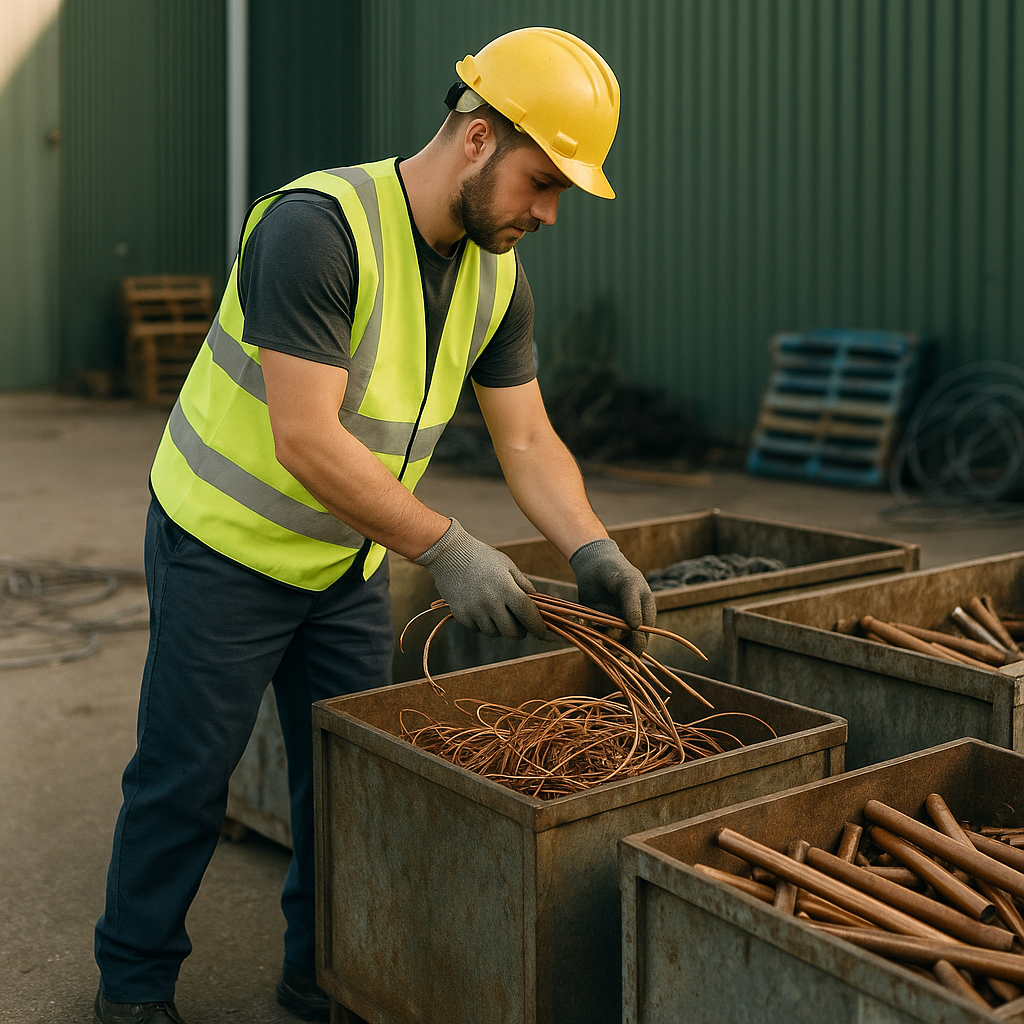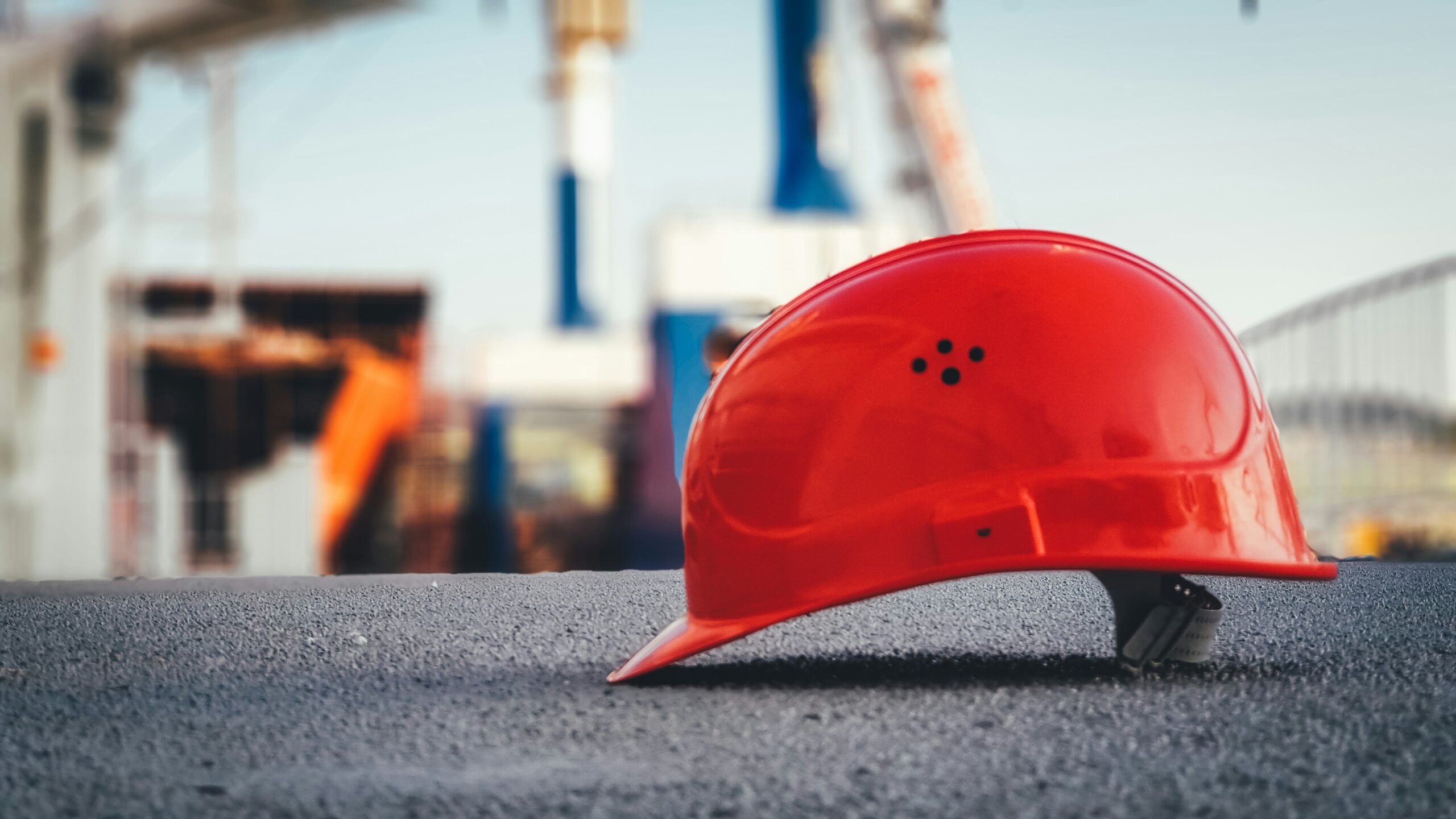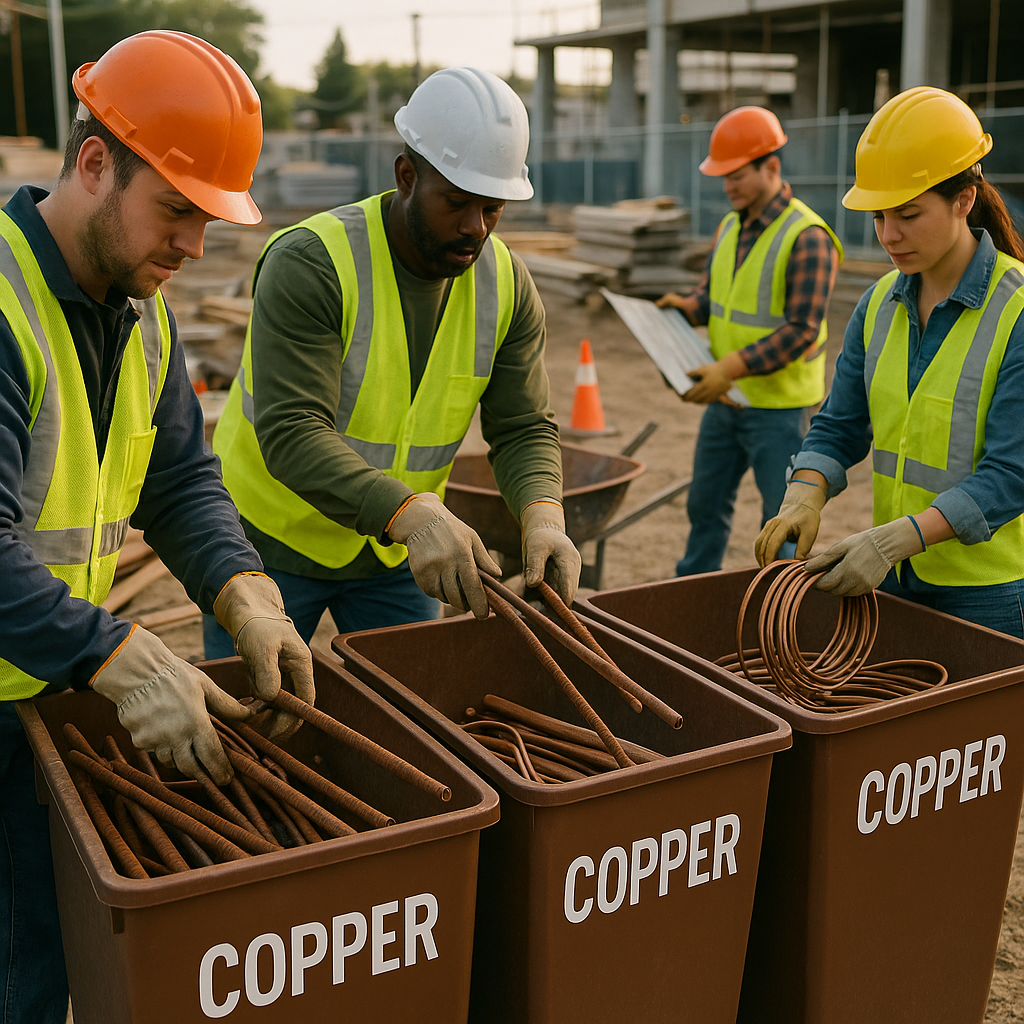5901 Botham Jean Blvd, Dallas, TX 75215
What is Copper Recycling for Construction Waste?
May 30, 2025The construction industry can reap significant financial benefits from copper recycling initiatives. Contractors who implement effective recycling programs transform what was once considered waste into a valuable commodity, creating multiple economic advantages throughout the construction process.
Construction and demolition projects generate substantial amounts of copper scrap found in wiring, pipes, and various fixtures. Instead of paying for disposal, companies can sell this scrap to recyclers, creating an additional revenue stream that directly improves project profitability.
The financial impact extends beyond immediate cash returns. By diverting copper from landfills, contractors significantly reduce waste management costs. Many regions charge increasing fees for construction waste disposal as landfills reach capacity. Recycling copper helps avoid these rising expenses.
Unlocking Competitive and Economic Advantages Through Copper Recycling

Creating Competitive Advantage
Construction companies that effectively recycle copper gain a competitive edge in project bidding. The revenue from recycled copper can offset other project costs, allowing contractors to submit more competitive bids without sacrificing profit margins.
Consider a renovation project generating 500 pounds of copper wiring and pipes. At current market rates, this could yield thousands of dollars in recycling revenue. Savvy contractors factor this value into their bid calculations, potentially undercutting competitors while maintaining profitability.
The financial benefits extend to clients as well. When contractors pass along savings from recycling revenue, property owners experience reduced project costs. This creates a win-win scenario that promotes sustainability while delivering economic value.
Supply Chain and Operational Benefits
Copper recycling significantly contributes to supply chain predictability. Market volatility affects virgin copper prices due to mining challenges and geopolitical factors. Recycled copper provides a more stable alternative with less price fluctuation, allowing for better financial planning and risk management.
The operational cost advantages are noteworthy too. Processing recycled copper typically requires about 85% less energy than mining and refining new copper. These energy savings translate to lower production costs throughout the supply chain. Construction companies benefit from these efficiencies through more affordable copper products.
Supply stability is another crucial benefit. Mining operations face increasing challenges from resource depletion and stricter environmental regulations. Recycling creates a reliable domestic supply of copper, reducing dependence on international mining operations and helping construction companies avoid supply interruptions that could delay projects.
Long-Term Economic Impacts
The economic benefits of copper recycling extend beyond immediate project gains. Construction companies that establish comprehensive recycling programs develop valuable expertise and infrastructure, creating opportunities for additional revenue through expanded recycling services.
Many regions offer tax incentives and financial support for sustainable construction practices, often including benefits for metal recycling initiatives. Construction companies can leverage these incentives to enhance project profitability while supporting environmental goals.
The market for recycled copper continues to expand as more industries prioritize sustainability. Construction companies that establish strong relationships with recyclers ensure access to the best prices and services, creating lasting economic advantages that benefit multiple projects over time.
How Does Copper Recycling Support Sustainability in Construction?

Copper recycling is a vital aspect of sustainable construction practices. It embodies circular economy principles by keeping valuable materials in use rather than depleting finite natural resources. The construction industry generates about 62% of all waste in the UK. Through effective recycling, copper can be continually reused without any degradation in quality or performance.
The environmental benefits of copper recycling in construction are substantial. Recycled copper requires approximately 85% less energy than extracting and processing virgin copper ore. This energy reduction directly translates to lower carbon emissions and production costs, making recycled copper about 13 times more cost-effective than primary production methods.
Resource conservation is another significant advantage. Global copper reserves could face depletion within the next 50-60 years at current consumption rates. Recycling extends the availability of this essential metal for future construction projects. The International Copper Association reports that roughly two-thirds of the 690 million tonnes of copper produced since 1900 remain in productive use today.
Reducing Environmental Footprint
Primary copper production involves extensive mining operations that can cause habitat destruction and biodiversity loss. Mining activities often disturb large tracts of land while generating tailings and waste rock that may leach harmful substances into soil and water sources. Recycling copper reduces these ecological disruptions by decreasing the need for new mining.
Water quality benefits significantly from copper recycling. Mining operations often impact local watersheds through acid mine drainage and sediment runoff. By reducing reliance on primary production, recycling helps protect water resources from contamination and preserves ecosystems that would otherwise be disrupted by extraction activities.
Carbon footprint reduction is another crucial benefit. The copper production process contributes significantly to carbon emissions. By choosing recycled copper for construction projects, companies directly contribute to climate change mitigation efforts and help meet global sustainability targets established in international agreements.
Energy Efficiency and Economic Benefits
The energy efficiency difference between recycling and primary production is remarkable. Processing scrap copper consumes only 10-15% of the energy needed for mining and refining virgin copper. This efficiency translates to substantial cost savings and reduced environmental impact throughout the construction supply chain.
Construction projects benefit from copper recycling through economic advantages beyond energy savings. Recycled copper provides a stable supply of high-quality materials at lower costs than newly mined copper. This economic efficiency makes sustainability financially attractive for construction businesses while supporting local economies through job creation in the recycling sector.
The market stability offered by recycled copper helps construction firms manage material costs more effectively. By reducing vulnerability to supply disruptions caused by fluctuations in copper mining, companies can better plan and execute projects with predictable material pricing and availability.
Quality and Performance Advantages
Recycled copper suffers no quality degradation compared to virgin copper. Unlike many recycled materials, copper can be recycled repeatedly without losing its essential properties. The electrical conductivity, thermal performance, and mechanical characteristics remain identical between recycled and virgin copper.
This quality preservation makes copper uniquely valuable in construction applications. From electrical wiring to plumbing systems, recycled copper performs exactly like newly mined copper while offering significant environmental benefits. Copper roofing made from recycled materials, for example, maintains the same distinctive patina and exceptional longevity as roofing made from virgin copper.
Construction components utilizing recycled copper include plumbing pipes, electrical wiring, HVAC systems, roofing materials, and energy-efficient heat exchangers. Each application demonstrates how recycled copper contributes to more sustainable building practices without compromising performance or durability.
Enhancing Brand Reputation
Companies that incorporate recycled copper into construction projects demonstrate tangible commitment to sustainability. This practice enhances corporate reputation among increasingly environmentally conscious stakeholders. As sustainability becomes a critical factor in project selection, the use of recycled copper can provide a competitive advantage.
The social benefits extend beyond reputation. Sustainable construction practices using recycled materials contribute to healthier indoor environments and improved quality of life. Buildings constructed with recycled copper support broader corporate social responsibility goals while showcasing commitment to environmental stewardship.
Forward-thinking construction companies recognize that using recycled copper helps meet growing client demands for sustainable building practices. Businesses can showcase their environmental responsibility through the selection of recycled materials, strengthening their market position while contributing to ecological preservation.
| Aspect | Recycled Copper | Primary Copper Production | Difference |
|---|---|---|---|
| Energy Use | 10-15% | 100% | 85-90% less energy |
| CO2 Emissions | Reduced | Higher | Lower emissions |
| Environmental Impact | Minimal | Significant | Reduced ecological disruption |
The integration of recycled copper into construction represents a significant step toward industry-wide sustainability. By conserving valuable resources, reducing energy consumption, minimizing waste, and maintaining material quality, copper recycling embodies the principles of the circular economy that modern construction increasingly embraces. As global copper demand continues to rise, particularly in renewable energy systems and sustainable building technologies, recycled copper will play an increasingly vital role in the construction industry’s environmental responsibility.
What is the Process of Recycling Copper from Construction Waste?

The copper recycling process involves several key stages that transform construction waste into valuable reusable material. This systematic approach ensures copper maintains its quality through multiple lifecycles.
Collection from Construction Sites
The process begins with gathering scrap copper from construction sites, demolished buildings, and renovation projects. Materials commonly collected include old electrical wiring, plumbing pipes, roofing materials, and copper components from HVAC systems.
Construction waste is a significant source of recyclable copper. Workers carefully identify and separate copper-containing materials from other debris to maximize recovery rates.
Sorting Based on Grade and Purity
Once collected, copper materials undergo meticulous sorting according to their grade and purity levels. This step ensures only suitable materials proceed to subsequent stages.
Advanced techniques such as magnetic separation and eddy current sorting help distinguish copper from other metals. Copper is categorized into different grades, with bare bright copper (uncoated wire) being the most valuable, followed by #1 copper (clean tubing without coatings) and #2 copper (containing minor impurities).
Preprocessing and Contaminant Removal
Before melting can occur, the sorted copper undergoes preprocessing to remove non-copper components. This includes stripping insulation from wires, removing paint or coatings, and eliminating soldering materials.
Cleaning is essential for ensuring the purity of the final recycled product. Contaminants like dirt, plastic casings, and other metals must be thoroughly removed to prevent quality issues in the recycled copper.
Shredding into Manageable Pieces
The cleaned copper materials then move to industrial shredders that break them down into smaller, uniform pieces. This step creates more manageable fragments and increases the surface area of the copper.
Properly sized pieces optimize the efficiency of the subsequent melting process. High-powered shredders tear through the scrap, creating uniform fragments that will melt more consistently in the furnaces.
Melting in High-Temperature Furnaces
The shredded copper enters industrial furnaces where it is melted at temperatures exceeding 1,000 degrees Celsius. This phase converts the solid copper fragments into a molten state.
During melting, some impurities rise to the surface as slag and are removed. The process requires significant energy, but recycling copper uses up to 85% less energy than extracting and processing new copper ore from mining operations.
Purification Through Refining Processes
The molten copper undergoes further purification to achieve the desired quality standards. Methods like electrolysis separate copper from remaining impurities by passing an electrical current through a solution containing the molten metal.
This refining stage ensures the recycled copper meets industry specifications for conductivity and performance. The purification process can produce copper with a purity level of 99.9%, making it suitable for high-demand applications.
| Grade | Copper Content | Characteristics | Common Sources |
|---|---|---|---|
| Bare Bright Copper | 99%+ | Unalloyed, uncoated, bright and shiny | Electrical wiring, bus bars, ground wire |
| No. 1 Copper | 95-99% | Clean, unalloyed, some slight oxidation | Plumbing pipes, copper sheet metal, bus bars |
| No. 2 Copper | 94-96% | Some oxidation, paint, or solder present | Used plumbing pipes, copper with soldered joints, roofing materials |
| No. 3 Copper | 88-92% | Significant impurities or alloys, extensive oxidation | Mixed metals, heavily oxidized materials |
Casting into New Products
After purification, the refined copper is cast into various forms for distribution. These may include ingots, bars, rods, or sheets depending on their intended use in manufacturing.
The solidified copper products serve as raw materials for new applications in construction, electronics, and other industries. Recycled copper maintains properties identical to newly mined copper, allowing it to be used in the same applications with no loss in performance.
Through this comprehensive process, copper from construction waste is transformed into a valuable resource that reduces the need for mining while maintaining the same quality standards as virgin materials.
How Can Construction Companies Maximize the Benefits of Copper Recycling?

The construction industry generates substantial copper waste through demolition, renovation, and new building projects. Strategic copper recycling reduces waste management costs, creates additional revenue streams, and supports environmental sustainability. Construction companies can optimize these benefits by implementing several effective strategies.
Implement Comprehensive Recycling Programs
A well-designed recycling program is crucial for effective copper recovery. Construction companies should establish dedicated collection systems at job sites with clearly marked containers specifically for copper materials. This prevents contamination with other metals and maximizes the value of recovered materials.
Regular audits of waste streams help identify missed recycling opportunities and refine collection procedures. Companies can track the amount of copper recovered from each project, allowing them to quantify both environmental benefits and economic returns. This data-driven approach transforms recycling from a compliance activity into a measurable business advantage.
For larger companies, appointing a recycling coordinator ensures consistent implementation across multiple job sites. This person can oversee collection procedures, manage recycling partnerships, and monitor program performance.
Partner with Experienced Recycling Facilities
Selecting the right recycling partner significantly impacts the value recovered from copper waste. Construction companies should research and evaluate local recycling facilities based on their processing capabilities, pricing structures, and environmental credentials.
The best partners offer transparent pricing, convenient pickup services, and detailed documentation of materials processed. Some facilities provide containers for on-site collection and scheduled pickup services, streamlining the recycling process. Establishing long-term relationships with reliable recyclers often leads to preferential pricing and improved service levels.
Construction companies handling large volumes of copper should consider negotiating contracts directly with recycling facilities rather than working through intermediaries. This eliminates middleman costs and maximizes returns on recovered materials.
Educate Staff on Proper Copper Waste Segregation
Staff education is a critical component of successful recycling programs. Workers need to understand which materials contain copper, how to properly separate them, and why recycling matters. Training should cover common sources of copper in construction, including electrical wiring, plumbing pipes, HVAC components, and architectural elements.
Regular training sessions keep recycling practices top-of-mind and help integrate them into daily operations. Visual guides posted at collection points can remind workers which materials belong in copper recycling containers. Recognizing employees who consistently follow proper recycling procedures reinforces the importance of these practices.
Companies can also implement quality control procedures to verify proper segregation before materials leave the job site. This additional step prevents contamination that could reduce the value of recycled copper.
Explore Local Incentives for Sustainable Practices
Many regions offer financial incentives for construction companies that implement sustainable waste management practices. These may include tax breaks, grants, or rebates that can offset the initial costs of establishing recycling programs.
Construction companies should research available incentives through local government agencies, utility companies, and industry associations. Some municipalities offer reduced permit fees or expedited approvals for projects that incorporate sustainable waste management practices. Taking advantage of these programs can enhance the financial benefits of copper recycling.
Participating in green building certification programs like LEED also creates opportunities to earn points for responsible material management, potentially increasing project marketability.
Leverage Recycled Copper for Brand Differentiation
Sustainable practices like copper recycling can enhance company reputation and create marketing advantages. Construction companies should document their recycling efforts and communicate these achievements to clients, stakeholders, and the public.
Marketing materials can highlight the environmental benefits of copper recycling, such as energy savings, reduced carbon emissions, and conservation of natural resources. Companies can include recycling statistics in project reports, proposals, and sustainability documentation.
For clients with sustainability goals, a strong recycling program may provide a competitive edge during the bidding process. Including recycling commitments in proposals demonstrates environmental responsibility and adds value beyond just project execution.
Some companies now incorporate recycled materials back into their projects, creating a closed-loop system that further enhances sustainability credentials. This approach resonates strongly with environmentally conscious clients.
Optimize Logistics and Collection Methods
Efficient collection and transportation systems reduce the costs associated with copper recycling. Companies should analyze their project locations and waste volumes to determine the most cost-effective collection methods.
For large projects, dedicated on-site collection systems with regular pickups may be optimal. Smaller projects might benefit from aggregating materials across multiple sites before transport to recycling facilities. Strategic planning of material transport can minimize fuel consumption and associated costs.
Monitor Market Prices and Time Sales Strategically
Copper prices fluctuate based on market conditions, so timing can significantly impact returns. Construction companies should monitor metal market prices and, when possible, time their sales to capitalize on favorable rates.
Some companies choose to store clean, segregated copper during price downturns, selling when markets recover. While this approach requires storage space, it can substantially increase returns over time. Building relationships with recyclers who provide market insights helps companies make informed decisions about when to sell their materials.
By implementing these strategies, construction companies can transform copper recycling from a simple waste management practice into a valuable business opportunity that delivers both environmental and economic benefits.
Conclusion: Embracing Copper Recycling for a Sustainable Construction Future
Copper recycling offers a significant opportunity for construction companies to balance economic benefits with environmental responsibility. It provides cost reductions by creating new revenue streams from materials that would otherwise become waste. Construction firms can sell valuable copper scrap to recyclers, offsetting project costs and enabling more competitive bids.
Beyond financial advantages, copper recycling supports the goal of a circular economy in the building sector. It conserves natural resources, uses up to 85% less energy than mining new copper, and significantly reduces the industry’s carbon footprint. This approach aligns construction practices with market demand for environmentally responsible building methods, offering companies a meaningful competitive edge. For construction businesses aiming to maximize the value of their scrap materials while contributing to environmental sustainability, Okon Recycling at 214-717-4083 provides expert solutions to integrate effective copper recycling into your waste management strategy.
